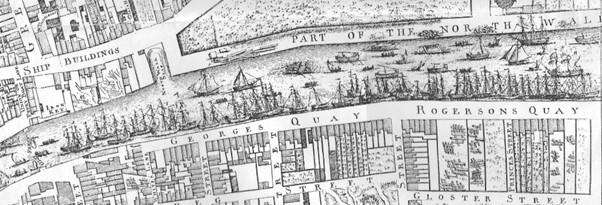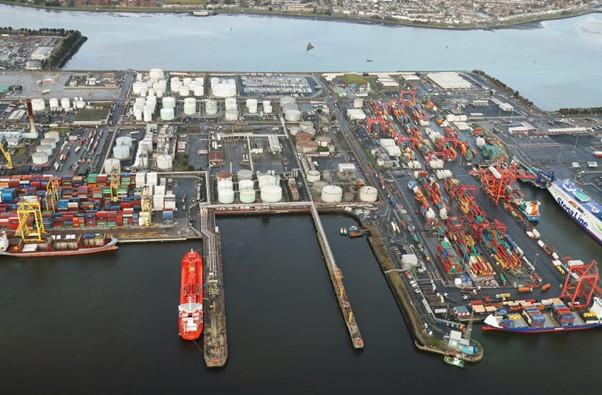Colm Murray

In Ireland, a Green Party Minister challenges the plans for the expansion of Dublin Port, in light of changing policy imperatives to mitigate climate change, social and ecological crises. The Minister for the Environment, Climate and Communications (which also includes Transport), Eamon Ryan, intervened with a policy direction in the Dublin Port Company’s consultation stages of drawing up a master plan for the ‘final’ future of Dublin Port. In this blog, researcher Colm Murray analyses the implications of this clash of visions about the future of this port as a node in the global trade system. The outcome of this discourse will indicate whether ports are sites where the meaning of sustainability may be formally contested, potentially directing change towards sustainability in local and international political economies.
Dublin is Ireland’s capital city, located on Ireland’s east coast as a result of geographical proximity to the former colonial power, England, through a sea-crossing and unequal terms of trade. The historical evolution and pre-eminence of the city and its hinterland results from this connection, leading to Dublin’s domination of the island of Ireland in terms of settlement and government. Dublin’s urban form was moulded by shipping, its river and quays accommodating trade. As ships got bigger, the port trading area moved downstream to the estuarine tidal marshes east of the city, and the quays became boulevards instead of docks, with the space of the river an intuitively legible dimension of the city, giving it a major aspect of its character.

During the late twentieth century, the lower waterfronts of the river were again transformed, as international shipping practice rendered labour-intense loading and unloading redundant, to be replaced by roll-on, roll-off containers (Hastings, 2002). In parallel, in 1987 a land development company, the Custom House Docks Development Company was set up to accommodate urban intensification (succeeded in 1997 by Dublin Docklands Development Authority, with an ever-larger area) on former port and local authority lands. In 2006, a road tunnel (dual carriageway) under the northern approaches was opened to link the port to the peripheral motorway, the M50. These have also impacted on the form of the city. Marine transport and trade shaped the ships, which in turn, in several iterations, shaped the city and thus the hinterland. This process continues, with the changing nature of maritime trade (for example, containerisation and increasingly larger vessels) continuing to impact on the use of land and water areas in the city. The reclaimed intertidal zone of the port will ultimately become the frontline for projected sea-level rise and storm surges.
Dublin is the main port for Ireland, with roughly 40% of the population of the Republic of Ireland living within 60km of the port. The Dublin Port Company is a semi-state body run by a board, predominantly appointed by the Minister for Transport. It recently drew up its third and final Master Plan (3FM) “to bring [the port] to its ultimate and final capacity by 2040”. This Master Plan is the ‘final’ bid of the port to remain in the centre of the city, because there is pressure for other city functions to take over the port lands and to move these to a new location. This is a vision of sustainability as a satiated or ‘maxed-out’ state, where all land is used as intensely as possible in the service of the economic system. The plan includes expanded ‘ro-ro’ and ‘lo-lo’ facilities, a 325m diameter vessel turning circle in the river, enhanced road access, as well as facilities for small crafts, and some housing and other infrastructure.
In a letter dated 20 April 2023, submitted in the consultation process on the 3FM, the Minister questioned the ‘growth as usual’ basis for these plans, demanding that the Port Company rethink or justify its growth projections (which were based on a simple 4% compound annual growth rate), and the assumptions built into its plans that road freight was the only relevant transportation mode to move goods out of and into the port. The Minister also challenged the Company to resolve conflicts between their plans and the Irish government’s policies ‘Climate Action Plans and the Whole of Government Circular Economy Strategy (2022-23)’ and ‘sustainable mobility and better-balanced regional development plans’. In a radio interview, the Minister asked rhetorically who and what all this stuff we are importing is for. After all, the critical point of a circular economy is to localise the flow of materials through space. The Minster has effectively challenged Dublin Port to become a valve, or indeed a tap, on the pipework of international maritime trade.
In addition, the letter critiqued presumptions about the plan’s share of the national gross tonnage of port traffic, which does not take into account the desirability of allocating a greater proportion of traffic to other, regional ports. The Minister proposed instead that port-owned lands could be allocated for other pressing needs, such as the chronic shortage of housing provision in Ireland, and to make space for nature in the UNESCO Dublin Bay biosphere reserve. This multi-objective thinking is a challenge to the commercial focus and conventional task-oriented governance of semi-state or parastatal enterprises. The implication of the Minister’s letter is to require, instead, that such organizations take on board the breadth of governmental policy agenda ‘in the wider interest of our city and country’. Can a semi-state enterprise use its land to achieve these broader public goods? While “[t]he Board remains focussed on ensuring the timely delivery of port critical capacity to meet projected demand and respond to the changing nature of maritime trade” (Dublin Port Company, 2023b, p.17), this dialogue will require it to broaden that focus. If it achieves nothing else, the Minister’s intervention sets the outlines of a policy or regulatory approach that the nation state might be able to take in relation to ecologically unsustainable global trade. In taking this position, he is reflecting European Union climate policies on circular economy “for a cleaner and more competitive Europe” (European Commission, 2023).
Interestingly, the port has already set up a heritage programme and employed a Heritage Officer to cultivate the rich past, social relations and public memory of the historical port. The integrated thinking about inheritances and landscapes (and seascapes) may contain the seed of a more sustainable vision. Dublin Port has for instance been an active partner in the recent Wales-Ireland Interreg project Ports, Past and Present. It may be too much for a commercial enterprise, however, to be entirely persuaded that its heritage function could inform its commercial strategy and lead it towards a stable, non-growth state of sustainability. The history of ports is marked by dynamism, but considering and dignifying their meanings for the communities they sustained may lead towards stability.
It is arguable that envisioning a final future state through a Master Plan is necessary to achieve a stable and steady future of a property, territory or place. However, constructing a viable vision for a stable and sustainable future must go beyond voicing platitudes in Corporate Mission Statements and Annual Reports, and impact on the methodology of economic and land use planning. European policies in relation to a circular (and therefore localised) economy will intentionally and necessarily curtail trade flows. Opening the valve of a port to maximise flows and justifying the move as a ‘once and for all’ final development has some of the characteristics of a so-called ‘Gattopardian transition’, as in ‘Yes, we will change, but only the minimum consistent with our fundamental (expropriative) interests’.
There is an implicit challenge to the paradigm of organizational and economic growth. The Minister asked: “What goods are these that are being imported?”, as less imports will be required from the port as the State moves to a more circular economy, relying less on imports and on imported fossil fuels (Magee 2023). Additionally, “Why is the Port Company not planning to move freight around by rail? I do not see how this 3FM project, which is predicated on continued reliance on road-based haulage, will contribute to the decarbonisation objectives being set at a national level for transport,” he said, “In fact, they would appear to run counter to these by encouraging more road haulage traffic and congestion. Cannot considerably more space be devoted to the needs of wildlife and habitat?”.

A Master Plan provides an overall context for future investment decisions, but the context must now include detailed awareness and sensitivity to the environmental agenda, until now very distant from the commercial realities of port planning and management. “Ensur[ing] there is harmony and synergy between the plans for the Port and those for the Dublin Docklands Area, Dublin City and the Greater Dublin Area” will require deeper thinking about these wider contexts and the negative impacts that ‘business as usual’ (Dublin Port Company, 2023b, p.17), projected into the future, will have on key climate crisis indicators. The Master Plan will have to be radically revised in light of the sustainability critique levelled at its economic underpinnings. A different future should beckon.
This may be the first instance of such political pressure being brought to bear on a port hub to align its development policies with those of sustainable development; specifically the impact a circular economic model ought to have on international trade, the decarbonization of sea transport, and alternative claims for the use of waterfront land for local housing and ecosystems. Where ports heretofore were often granted the autonomy to respond to changing dynamics at play in global geographies within a free market paradigm, in the case of Dublin, these assumptions are now being audited. We are seeing the evolution of the port finally being shaped by questions and priorities that are formulated not solely on economic bases, but on wider societal and environmental ones. It remains to be seen whether the Irish State can impact on the global system of mercantilist goods flows.
Acknowledgement
Colm Murray is an independent heritage conservation and planning consultant. He has written about building conservation and sustainability and about the role of land use planning in making society converge towards sustainable states. He is currently working towards publishing the results of a recent study, ‘The Social and Public Value of Heritage’.
This blog has been written in the context of discussions in the LDE PortCityFutures research community. It reflects the evolving thoughts of the authors and expresses the discussions between researchers on the socio-economic, spatial and cultural questions surrounding port city relationships. This blog was edited by the PortCityFutures editorial team: Carola Hein and Vincent Baptist.
References
Custom House Docks Development Authority (1987). Planning Scheme.
Dublin Port Company (2023a). “3FM Project.” https://www.dublinport.ie/masterplan/3fm/.
Dublin Port Company (2023b). Annual Report 2022. https://www.dublinport.ie/wp-content/uploads/2023/07/DPC_Annual_Report_2022.pdf.
European Commission (2023). “Circular Economy Action Plan.” https://environment.ec.europa.eu/strategy/circular-economy-action-plan_en.
Hastings, B. (2002). “Emptying the River,” in: Campbell, H. & Hastings, B. (eds.), Tracings 2, Dublin: UCD School of Architecture.
Magee, H. (2023). “Eamon Ryan Expresses Scathing Criticism of Dublin Port Plans in Unprecedented Intervention,” The Irish Times, 21 April 2023.
Ryan, E., T.D., Minister for Transport (2023). Letter to Jerry Grant, Chairperson of Dublin Port Company, dated 20 April 2023.
